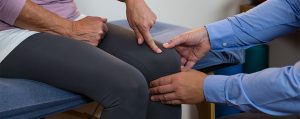Woke Up On The Wrong Side Of The Bed? 4 Stretches To Alleviate Back And Neck Pain
Do you ever wake up in the morning with a stiff neck or lower back? Maybe you can’t get comfortable in bed at night or “slept on your neck wrong”. Tightness in your neck or stiffness in your back is the last thing you want to start your day. You get up ready to go to work or school and your neck or back slows you down. Let’s look at four stretches you can do to start your day off right.
Occupational Therapy Or Hand Therapy? How To Decide Which Is Best For You
Occupational Therapy
When you think of Occupational Therapy, do you think “work”? Many do! But that is too narrow. Occupational Therapy focuses on returning the student, client, or patient to daily tasks they need/want to do throughout their life. These functional tasks are labeled “occupations” and include feeding, dressing, bathing, house and yard chores, meal preparation, school work, driving, caregiving, recreation, and work too! This list is not exhaustive, and the different “occupations” importance varies with age, injury/illness, and individual goals. For example, in pediatrics, an Occupational Therapist obviously will not work on driving skills with a preschooler. Occupational Therapists evaluate and collaborate with the individual to implement a customized treatment plan and re-evaluate with functional outcome measures to assess progress toward the individual’s goals.
How Long Does ACL Recovery Take?
Approximately over 250,000 people tear their ACL every year, with the most at-risk population being young female athletes.1 Despite being a common injury, every ACL reconstruction rehabilitation is different. Protocols depend on graft type, concomitant injuries like meniscus or MCL, and surgeon preference. For this reason, ACL protocols need to be a combination of both criteria-based and time-based. From a criteria-based perspective, physical therapists need to make sure athletes can get back to squatting, jumping, landing, cutting, and all other sport-related tasks with good mechanics to set them up for success as they return to sports. From a time-based perspective, physical therapists need to consider tissue healing time and appropriate tissue loading. Each athlete achieves their objective criteria at different times. It can take anywhere from 6 months to 24 months post op for athletes to get back to full participation, with a majority of athletes returning to sport between the 9- and 12-month mark.
How to Succeed in PT following ACL Reconstruction Surgery
“I don’t really have the words right now, definitely not the right ones at least,” this was the quote from Odell Beckham Jr. following his 2nd ACL tear during Superbowl LVI. Most people know that an ACL tear is a common knee injury that requires a long, tenacious recovery. Once an ACL is torn, the risk of re-tear or tearing the opposite side is 20-35% more likely4. The above statistic may be alarming and is why ACL reconstruction rehabilitation needs to be taken very seriously.
How PT Can Help You Shake Your Frozen Shoulder
Adhesive capsulitis, or as it is more commonly referred to, frozen shoulder, is a severe and long-term problem. It affects 3-5% of the general population, women slightly more than men, typically between 40-60 years old, and is 4x more likely in people with diabetes. The cause of primary adhesive capsulitis is unknown, but secondary adhesive capsulitis occurs when there is already known primary injury to the shoulder. However, the recovery process can be faster with physical therapy, and you can return to your previous full function. There are three phases of frozen shoulder: freezing, frozen, and thawing.
How PT Can Help You Put Migraines in the Past
Imagine a scene that may be familiar to you: You are moving through your day when suddenly, a migraine hits. You may have to call into school or work. You may become nauseous or dizzy. You feel pain in your head and neck. You may even only be able to feel better if you lay down in a dark, soundless room alone and wait for the migraine to pass or your medication to begin working. Migraines are a debilitating condition with over 3 million US cases each year and become very common from age 6 to above 60. But did you know there are more options for you than just medications and lifestyle changes? Physical Therapy is a worthy option to assist in the treatment and may even help you get better faster.
3 Ways to Roll Away Muscle Tension
Sedentary jobs, decreased activity levels, and increased stress have made us a less mobile population. Our muscles are overactive and tight, creating imbalances in our bodies, which can lead to poor posture, joint pain, and a host of avoidable injuries. Most of us can’t afford a live-in masseuse, and massages from our significant others are expected to be reciprocated (and who wants to do that?), so how are we supposed to alleviate our tense, overactive muscles? Below I have 3 options for you, each with its own advantages and disadvantages. (more…)

